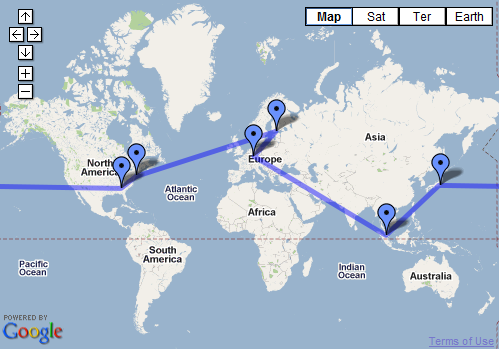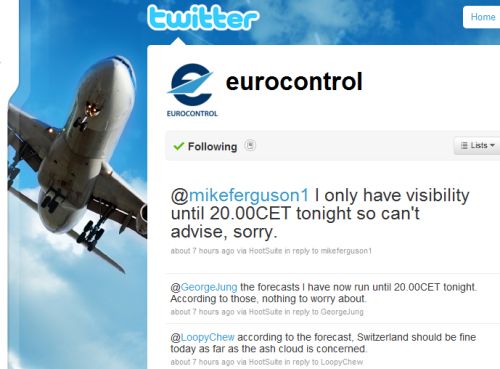Sometimes things don’t go exactly like you planned them. In April 2010 quite many of us European travellers were reminded of this, as the eruption of the Eyjafjallajökull volcano far up north managed to bring the air traffic into a near standstill. At the time of the news about the possible impact of the eruption, I was spending my week in Kuala Lumpur, giving training to my colleagues at our Malaysia office. I had a return flight booked for Friday night on April 16th, but I didn’t actually return home until May 1st.
I could have flown home earlier, but I had previously reserved a ticket to Microsoft Convergence 2010 conference in Atlanta, US (you can read more about it in my CRM blog, part1 and part2) that was scheduled to start on April 24th. Since it began to look obvious quite soon that the flights in Europe would be affected for several days, I decided to re-route myself directly from Malaysia to US, without visiting home base. So, as a result, I performed my first ever around the world trip in quite a spontaneous manner.
Me and my colleague were of course lucky to be stuck in such a nice location as Kuala Lumpur. Furthermore, we were able to easily extend our stay in the same Sunway Pyramid Tower Hotel, thus removing the need to spend our time searching for alternative accommodation. On the night of our planned return date, Friday 16th, Malaysia Airlines still insisted on the web at 20:00 that their 23:55 flight to Amsterdam would depart as scheduled. Having viewed all the news online and putting 2 + 2 together, we decided to keep our heads cool and our luggage unpacked, since going to KL International Airport would have not served any purpose. At midnight the flight was cancelled and the world slowly started to come into terms with the true level of impact to the European air traffic from the looming volcanic ash high up in the clouds.
Even though Malaysia Airlines only has a few flights to Europe, their customer service phone number was totally unreachable on the next morning. Therefore we decided to take a taxi from Petaling Jaya to the MAS office in KL Sentral and visit a physical service desk, where we were given new tickets for the same flight on Sunday. Still, we didn’t really get our hopes high, because it was quite clear that in a situation such as this no one could truly know what was going to happen, not the airlines nor the passengers. It was a true force majeure if I’ve ever seen one.
If the same event had occurred in 1995, I have no doubt that we would have been royally screwed, totally at the mercy of travel agency service representatives acting based on the official but false information given to them by someone higher up in the chain. Luckily we lived in the year 2010 and in a world full of online information sources and social media channels. I quickly became virtual best friends with @eurocontrol, the Twitter account of the European organisation for the safety of air navigation. They provided real time links to press conference events and materials through their tweets, thus giving the most cutting edge information available to any media, as Eurocontrol effectively made the decisions who could fly and where.
What I was doing for the four extra days while being stuck in KL was effectively running a virtual situation room on my laptop screen, collecting pieces of information like airport departure/arrival data, news bulletins from officials, weather forecasts, interviews etc. in order to formulate a best guess scenario of what was going to happen within the next hours and days. It was a true case of the wisdom of crowds in action, similar to the phenomenon we’ve seen during many of the natural disasters in the 21st century, where the best and most reliable information does not come from any single media giant but rather from leveraging all the small content streams out there. When it came to extending our hotel room reservations, at one point I realized that I didn’t really need to necessarily even have a room for me and my stuff for the day, but what I could not survive without was a reliable internet connection. Although €14 per 24h was a steep connection rate compared to the €80 per night for a four star hotel room, it was a price I was more than happy to pay (and charge to my employer later on of course).
On Sunday afternoon it had become quite clear that if I wanted to make it to the US in six days, flying through Europe was out of the question. I started to look for alternative connections which would take me there through the other side of the globe. I found a route that would fly me from KL to Atlanta through Tokyo in 32 hours and decided that it was the best deal I was going to find in the current situation. Thanks to the magical power of the internet, booking the flights, hotels and rental cars on the fly was not too difficult. Figuring out exactly what kind of data the US immigration officials wanted to have of my trip in how many systems and by what date was actually a much bigger task. Not surprisingly, our corporate travel agency Kaleva Travel was swamped with 1000 times more service requests than usual. Combining that with the fact that it was the weekend, self service was the only way to go. At the end, the only thing I really needed the agency for was to push the button on writing the final ticket for my US-FIN return flight reservation, as I didn’t want to board the plane without a printed return ticket. Printing documents (such as boarding passes) while on the road – yeah, that’s another one of those small but pesky hurdles of travel, still in the year 2010.
On Tuesday night at 22:00 I started my journey from KLIA to Narita airport in Tokyo, where I landed 07:00 local time. It was a whopping 8 hours stop before the next departure, which would have given me plenty of time to visit downtown Tokyo. However, I was wearing just a short sleeve shirt and the weather outside was +12C and raining, so I decided to stay at Narita and instead took a day room for a couple of hours to catch some sleep. Besides, I had done a one day tour around Tokyo last year, so “been there, done that” I thought. Boarding the Delta jumbo at 15:00 in Tokyo and stepping out of it at 15:00 in Atlanta on the same exact day was quite a strange feeling, but at that point I was already detached from all of the time zones in the world. I barely managed to climb into my rental Chevy HHR and navigate my way along Interstate 75 (a whopping 15 lanes at the biggest interchange!) to my final destination, Residence Inn in Kennesaw. From the moment of waking up in the hotel bed in Kuala Lumpur and falling asleep at the next one in Georgia, US, the 50+ hours in between definitely felt like one of the longest days in my whole life.
The stay around the Atlanta metropolitan area was a pleasant one. Not that I had much free time on my schedule, between moving from our Kennesaw office to downtown Atlanta for the conference and then back again. The weather was surprisingly cold and did not really fit well with my wardrobe geared for a stay in Malaysia. Even the rain in Atlanta was much harder than what they have in Southeast Asia, thanks to a tornado that passed through Georgia during the weekend I was staying there. I tried to avoid eating too many supersize meals, but I have to say the burgers they have on offer in the States make it a difficult task. Cruising around the suburb area in my Ford Mustang, grabbing a McMuffin to go and shopping at Walmart gave at least some taste of the local lifestyle. My return flight to Finland was through New York, and with 5 hours to spend at JFK, I decided to also make a very quick trip to Manhattan: train to Penn station, a walk around Madison Square Garden, burger meal on 9th Avenue, a couple of photos of the Empire State Building and then back to Helsinki to celebrate 1st of May. Finally!
All in all, I’m glad to have made the trip around the world, but I’m just hoping that next time I will have the chance to focus a bit more on enjoying the trip itself and not so much on the arrangements of it.



0 Responses
Stay in touch with the conversation, subscribe to the RSS feed for comments on this post.